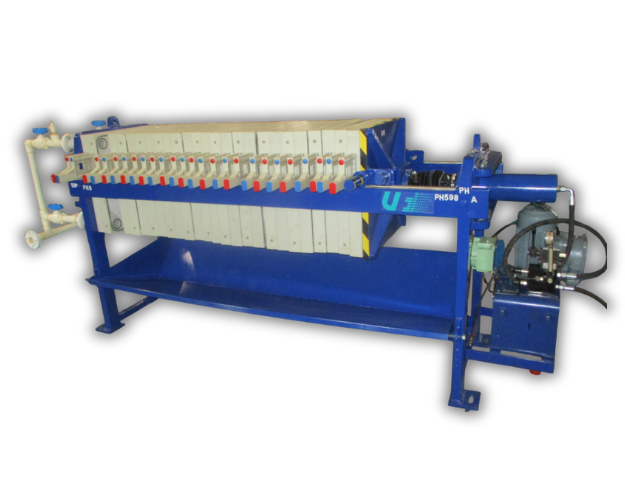A filter press is one of the most efficient and widely used solid-liquid separation machines in industries such as chemicals, pharmaceuticals, food, mining, textiles, and wastewater treatment.
Its ability to produce a clear filtrate and a dry filter cake makes it a preferred choice for industrial filtration.
In this complete guide, we explain what a filter press is, how it works, its components, types, applications, benefits, and why businesses rely on this technology.
What is a Filter Press?
A filter press is an industrial filtration machine that separates solids from liquids using pressure filtration.
It consists of a series of plates covered with filter cloths. Slurry is pumped into these chambers, where solids are trapped and liquids are released.
A filter press is known for:
High filtration efficiency
Ability to produce very dry filter cakes
Low operational cost
Consistent performance
Industries prefer filter presses because they deliver reliable results even in demanding conditions.
How Does a Filter Press Work? (Step-by-Step Process)
The working principle of a filter press is based on pressure filtration. The slurry is pumped into the machine, and pressure forces the liquid through the filter cloth while solids remain trapped.
Below is the detailed process:
1. Slurry Feeding
The filtration cycle begins when slurry (solid-liquid mixture) is pumped into the filter press.
Slurry enters the chambers created by filter plates
Pressure increases as chambers fill
Solids settle against the filter cloth
Higher pressure results in faster and more efficient filtration.
2. Filtration Through Filter Cloth
Each filter plate is wrapped with a filter cloth that acts as the filtration medium.
Filter cloth captures solid particles
Liquids pass through the cloth pores
Filtrate moves into drainage channels inside the plates
The pore size of the cloth determines filtration quality.
3. Filtrate Outlet
Once filtrate passes through the cloth:
It flows through internal channels
Exits from the outlet port
Collected filtrate is either reused or discharged
The clarity of filtrate depends on the cloth, pressure, and slurry quality.
4. Formation of Filter Cake
As the slurry continues entering:
Solids accumulate layer-by-layer
A dense and dry filter cake is formed
Filtration slows as cake thickness increases
This filter cake signals the end of the filtration cycle.
5. Plate Opening
Once filtration is complete:
Automatic or manual mechanisms open the filter plates
The operator or system separates the plates
The filter cake becomes visible
The method of plate opening depends on the type of press.
6. Cake Discharge
The final step is cake removal.
The filter cake drops automatically or is manually removed
Cloth is cleaned if required
The press is closed for the next cycle
The efficiency of cake discharge varies between manual, semi-automatic, and automatic filter presses.
Types of Filter Presses
Filter presses come in different configurations depending on automation level and application requirements.
1. Manual Filter Press
All operations are manual
Best for small to medium industries
Low cost and low maintenance
Ideal for controlled batch filtration.
2. Semi-Automatic Filter Press
Some operations automated
Manual involvement still required
Faster and safer than a manual press
Suitable for growing industries.
3. Automatic Filter Press
Fully automated operations
Fast cycle time
Low labor requirement
Ideal for large industries requiring high production.
Major Components of a Filter Press
A filter press consists of multiple essential parts:
Filter plates
Filter cloth
Hydraulic or manual closing system
Structural frame
Slurry feed pump
Drip trays
Filtrate outlet system
Plate shifting mechanism
Each component plays a role in achieving efficient filtration.
Applications of Filter Press
Filter presses are used across various industries:
Chemical processing
Wastewater treatment
Food and beverage industry
Mining and minerals
Aviation and metal finishing
Dyes and pigments manufacturing
Pharmaceuticals
Oil and edible industries
Ceramic and clay processing
Any process requiring solid-liquid separation benefits from a filter press.
Benefits of a Filter Press
Filter presses offer several advantages in industrial operations:
● Produces a dry and solid filter cake
● High filtration quality
● Low operating costs
● Suitable for a wide range of industries
● Customizable to different capacities
● Reduces waste volume
● Energy efficient compared to other filtration systems
Why Choose UltraFiltech for Filter Press Solutions?
UltraFiltech is one of the leading filter press manufacturers in India, offering:
Manual, semi-automatic, and automatic filter presses
High-quality plates and durable filter cloths
Custom sizes from 300 mm to 1500 mm
Strong and corrosion-resistant frames
Quick service support and spare parts availability
We provide reliable filtration solutions for industries of all sizes.
Conclusion
A filter press is a powerful and efficient machine used to separate solids and liquids in industrial processes.
Its simple yet effective working principle, combined with its ability to produce a dry cake and clear filtrate, makes it an essential tool across multiple industries.
Whether you need a manual, semi-automatic, or fully automatic filter press, UltraFiltech delivers high-performance machines engineered for long-lasting operation.

